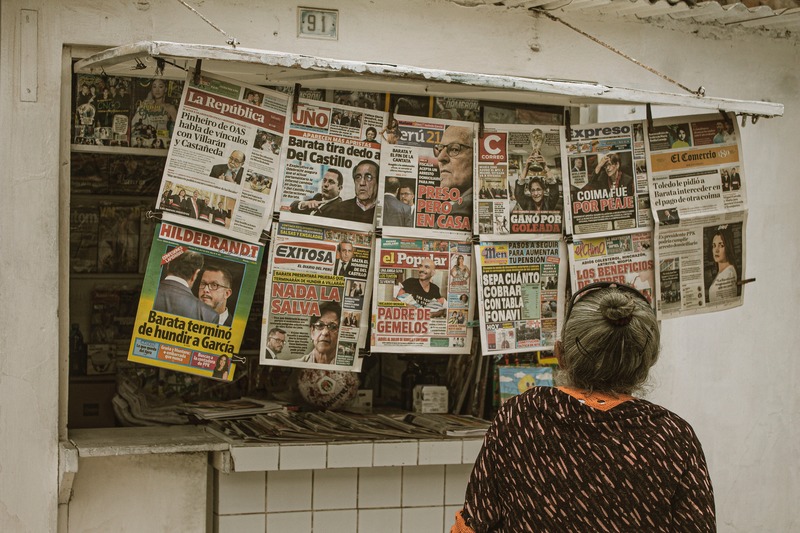
Fake news is a term that has been circulating for a while now but what does it mean exactly and why is it so important to be aware of it? The term “fake news” describes any article or video containing untrue information disguised as a credible news source. Whether it is online or on the television, fake news can be found just about anywhere which is why it has become such a big problem in society today. Why does it need to be stopped? Fake news is extremely harmful. Its goal is to manipulate and persuade its audience to believe incorrect information. Read on to discover more about fake news and what is being done to stop it.
What are the different types of fake news?
Now that we know what fake news is, let’s get more into the deeper details. As we know, its intention is to manipulate, mislead, and fool its viewer into thinking a certain way about a certain topic by appearing like the truth. Fake news can come in all different formats whether it is via the media or word of mouth there are several different types of fake news to watch out for. Read on to discover some of the most common styles circulating the media.
Intentional
Intentional deceptive news is news that has been created to cause confusion and mislead on purpose. In many cases, intentional fake news has been fabricated to make money. Money can be made by viewers clicking on outlandish headlines to discover more. It is commonly used as a publishing trick to increase webpage views and associated advertising revenue. It is an emotional trap that many succumb to by clicking on hyperlinks. More often or not; intentionally deceptive fake news can be found online on fake news sites. Usually videos, images and graphics have been manipulated to legitimise the story as seen in our article on the war in Eastern Europe.
Misleading
This style of fake news is normally created to serve a certain agenda. It can be sort of true by being initially based on a true story to gain headlines but then taken in a different direction with no reliable sources or fact-checking. It is used in the wrong context to create a buzz and make big headlines - a misinterpretation of expansion of the truth. Misleading news tends to support an ongoing narrative with added fooling features.
Bad Journalism
Reporters may produce stories on events and newsworthy topics without gathering all the verified facts. In many cases, they are fighting against the clock and adhering to an extremely tight deadline to get the story published, leaving a lot of room for error. In other cases, some journalists can be sloppy and not bother to check the facts before publishing. Whatever the case, they are reporting unreliable information that can be labelled as fake news.
Parody
Online websites such the Daily Mash or Gorafi produce fake stories to be humorous. Although this news is not intended to harm or mislead, when shared out of context it has the potential to be read the wrong way.
Propaganda
Propaganda is another style of fake news. This form of news is designed to promote a certain political or ideological agenda. It originates from political points of view with the goal of increasing public awareness around a particular political stance or point of view
Lobbying paid content
The term lobbying can take a wide variety of forms but when associated with fake news, it is a service that is used to fund campaigns to increase public awareness in exchange for a fee. Lobbying can be used through various media outlets including newspapers, magazines, social media, and television channels.

How has fake news become such a problem?
Fake news is nothing new. Since the early 19th century, when newspapers and journals came on the scene, sensationalist headlines and fake stories were used to sell papers. However fake news today is a much bigger problem than it was in the past thanks to improved technologies.
The digital era we now live in means that information can be spread at the speed of light. The internet has revolutionised the way in which we consume information. Although it has brought about several positive changes to the way we live and learn as a human race, the outpouring of fake news and misinformation online cannot go unmissed. Technology does not always serve the users’ best interest which is why it is important to protect ourselves against fake news. Stories are created to influence the public’s opinion, push certain political agendas, make a profit or simply just to create general confusion surrounding a topic.
Younger audiences, who are the biggest users of social media, are the most susceptible. They are particularly vulnerable to fake news and propaganda as they spend a large part of their time online and in the digital world. They rely heavily on information being circulated online to gain access to what is happening in the world. This therefore influences their access to knowledge and how they perceive media.
How to decide whether an article is fake?
We now have an understanding of what fake news is and the different styles in which it exists. What can we do to avoid it as much as possible? How can we avoid being taken in by misleading information? Thankfully, there are several clues to look out for to help stop the further spreading and believing of fake news in the media. Discover some simple tips so you will never be fooled again!
Emotion and Tone
The goal of any headline is to provoke and stimulate emotion. Fake news stories often have buzzy titles all in capital letters to catch the reader’s attention. If the headline is over emotional, extremely shocking and doubtworthy, then it should usually not be trusted. It is important to be aware of what this news story is making you feel and why. Do not be deceived by catchy titles and articles whose sole purpose is for you to click on a link to something that is not real.
The Source
Check the source. Where did this article or headline come from? Is it a reputable author and what types of publications do they write for? A few simple questions can help determine whether there could be a smidge of doubt to the validity of what you are reading. Always make sure to check the story’s source if you feel like you need to dig a little deeper.
Images
Modern editing has made it easy for images to be manipulated and transformed online. It is extremely easy to make fake images that appear real. Although it can be hard to determine whether an image is fake there are some warning signs to look out for. If there are odd, jagged edges, bizarre shadows, or any blurry parts, then there is a high chance that the image has been manipulated.
Social media
As mentioned, social media platforms are the biggest spreaders of fake news. If a story first appears on social media there is a chance that it could fake, misleading or biased. Check credible news sources to see if they too are reporting the same story in a similar tone of voice.
Fact Check
If ever in doubt, check the facts. A good rule of the thumb is to see if you can find the same news story from several other sources. If you cannot find the story anywhere else, it is likely it is fake. Check the timeline and dates to make sure the story adds up. In fake news this is often wrong.
What is being done to stop fake news
Whether it is celebrity gossip or political issues, the spreading of fake news is only getting worse. However, the fight for the truth is at an all-time high and there are several solutions that have been put in place to stop the spreading of false news stories.
The social media platform Twitter has rolled out several solutions in the fight against fake news spreading online. They created a crisis misinformation policy to make sure it does not add to falsehoods during periods of wide shares. To discover whether a tweet may be false or misleading, Twitter requires verification from credible sources, including conflict monitoring groups, humanitarian organisations, journalists, and open-source investigators.
If a tweet is found to be untrue or misleading, Twitter will automatically turn off any likes, reshares and retweets. These misleading tweets will be taken down from any homepages. The social media platform also requires users to confirm their identity with an email address or phone number to stop the creation of false accounts.
Facebook was one of the main social media platforms that was heavily criticised for allowing fake news to spread so quickly, most prominently during election periods. However, the network has taken several impressive steps to stop the issue. One step was enlisting the International Fact Checking Network (IFCN).
Facebook users can flag articles that they think could be false which will then automatically go to third-party fact checkers who have signed up to the IFCN. These fact checkers are from reputable media companies. In 2017, Facebook started the Facebook Journalism Project. By partnering with news publishers and nonprofits they can help combat misinformation, promote news literacy, share best practices, and improve what’s being spread online. Creating links between journalists and the public reassures what’s being put out in the world is legitimate news and content.
Algorithms
Algorithms are in fact a player in how fake news is spread. Stories are pushed via algorithm software that runs social networks. However, it is possible that computer code and algorithms could indeed also be a part of the solution to diminish the spreading of fake news stories. Fact-checkers need help to catch up with the speed and breadth of information being spread quickly. This is where computer algorithms alongside artificial intelligence can step in to help them pick up the pace. Algorithms can help look for stories that are being shared fast and determine whether they are legitimate or not.
In 2020, during the coronavirus pandemic, Google invested $6.5 million to fund fact-checkers and nonprofits fighting against misinformation. Since then, Google has continued to increase their efforts to stop false news and misinformation being spread. In early 2022 they added a new range of search upgrades and alerts so that Google users can better understand the sources of where they are getting their updates from. They have also added a new notice on evolving news stories to alert their users that the facts of this story are still being verified. It also includes tips as to how the user can evaluate the information online. Small alerts like this are often what it takes for the user to pause and think twice about the information being shared.
Silence can be golden
As much as large corporations and artificial intelligence are helping in the fight against fake news, there are also many things that the public can do to help stop misinformation being spread. Although tempting, engaging in any form of false information online will only increase its visibility. Any comments, even if made to disagree with the post’s purpose, cause the information to be shared to more individual networks leading it to achieve more views along with likes and dislikes. Any interaction is how false information can be spread fast. In this case, keeping quiet and ignoring what’s been said can sometimes be better than speaking up!
Why do we need to protect ourselves against fake news?
The internet has revolutionised the way in which we consume information. The digital world has opened an infinite number of opportunities. It has, of course, brought some extremely positive change. However, the digital world has presented society with various challenges that cannot go unmissed
Technology does not always serve its users’ best interests, which is why it is important to know what fake news is and how it is spread so we can protect ourselves against it. Possibilities to counter this recurring phenomenon include ensuring that the information we read and view is safe and secured. Companies can and should help by certifying the content they put out. Technology can help: thanks to blockchain-backed tools such as Wiztrust, companies can make sure that the information they put out is certified and unmistakable with a fake.
Check this article if you want to know how to protect yourself against fake news.


 On 4 November, 2022
On 4 November, 2022
 8 min
8 min
